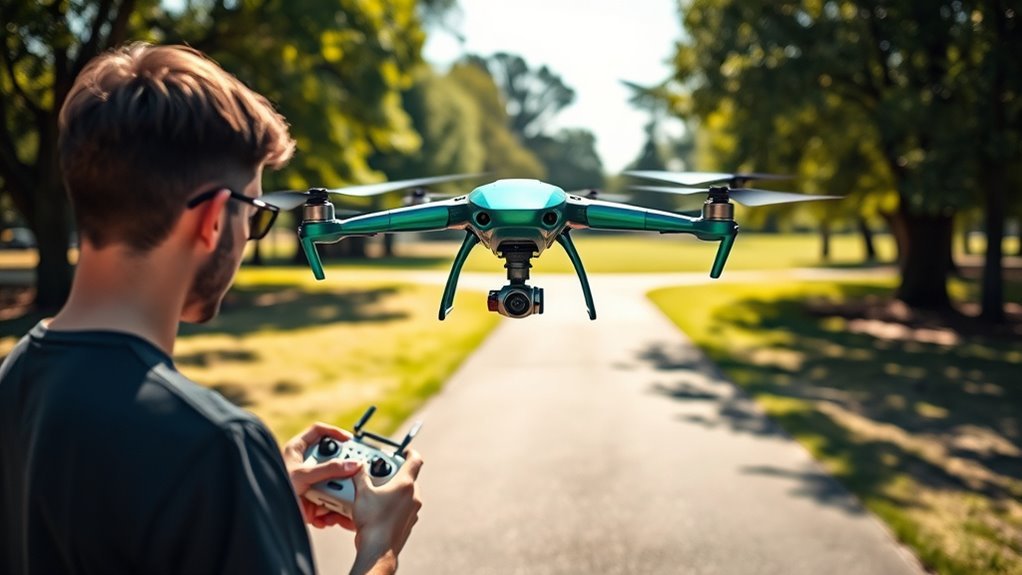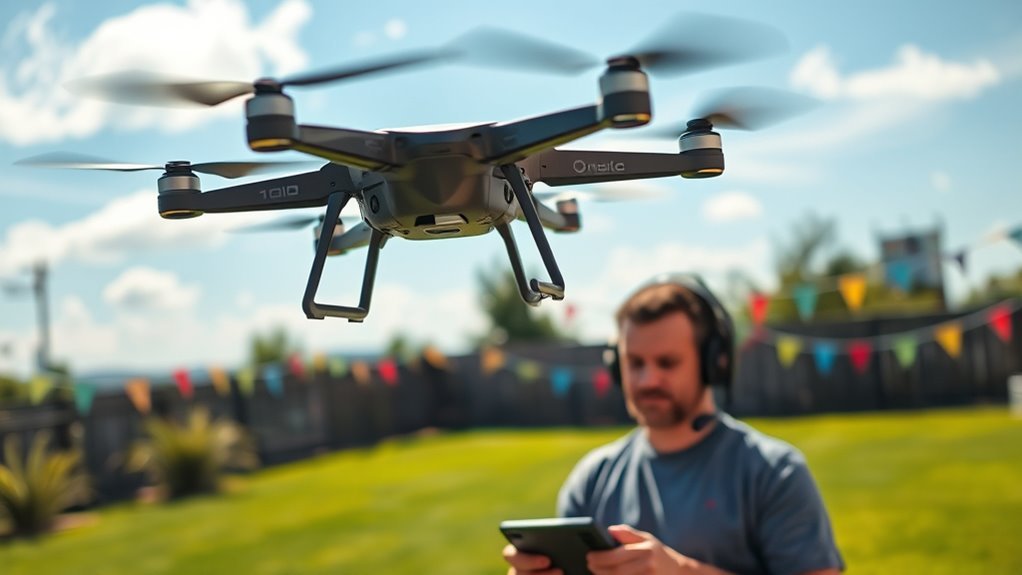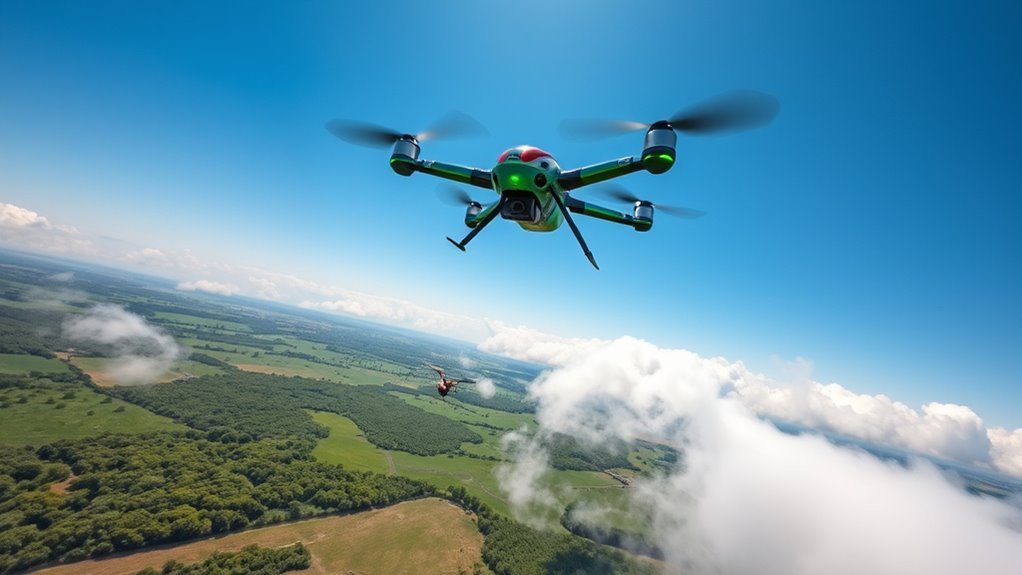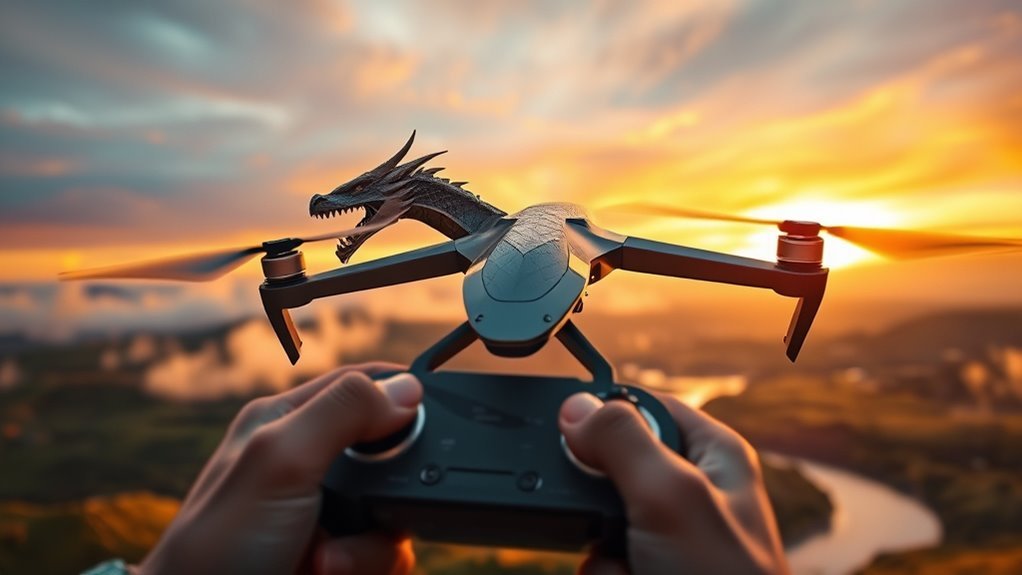To train your Dragon Drone, start by understanding its features, like flight time and camera capabilities. Prioritize safety with proper gear and a pre-flight checklist. Familiarize yourself with basic controls for smooth handling. Once you’re comfortable, practice aerial stunts like loops and rolls, then advance to maneuvers such as dives and sharp turns. Capture stunning footage using techniques like the rule of thirds. There’s much more to enhance your skills and enjoyment waiting for you.
Understanding Your Dragon Drone’s Features

When you’re getting to know your Dragon Drone, it’s essential to familiarize yourself with its key features to maximize performance. Start with the feature overview, which includes the drone’s flight time, typically around 25-30 minutes, and its range of up to 1.5 kilometers. Understanding these drone specifications will help you plan your flights effectively. Pay attention to the camera capabilities, such as 4K resolution, which offers stunning aerial photography and video. The intelligent flight modes, including waypoint navigation and follow-me, provide enhanced versatility, catering to your adventurous spirit. Additionally, learn about the battery status indicators and obstacle avoidance sensors, which guarantee safer operations. Mastering these features empowers you to explore the skies with confidence and freedom. Moreover, consider how advanced obstacle avoidance systems enhance safety during your flights, similar to the technologies found in top-tier drones like the Skydio 2. This includes multi-directional sensors that provide 360-degree awareness of surroundings, ensuring a safer flying experience.
Preparing for Flight: Safety First

Before you take to the skies, it’s crucial to guarantee that all safety measures are in place to protect both your Dragon Drone and those around you. Start by donning your safety gear—this includes goggles to shield your eyes from potential debris and sturdy shoes to protect your feet. Next, conduct a thorough pre-flight checklist: verify your drone’s battery is charged, propellers are securely attached, and all controls respond correctly. Check weather conditions to avoid flying in high winds or rain. Additionally, ensure you are familiar with local drone regulations to comply with the laws governing your flight, as state regulations may impose additional altitude restrictions. Identify a spacious area away from people and obstacles for your flight. By following these steps, you’re not only safeguarding your drone but also embracing the freedom of the skies responsibly. Fly smart, and enjoy the adventure!
Basic Flight Controls and Techniques

Mastering the basic flight controls of your Dragon Drone is essential for a smooth flying experience. Start with your remote’s left joystick, which controls altitude and rotation; push it up to ascend and down to descend. The right joystick governs direction—move it left or right to yaw your drone. For forward and backward movement, push the right joystick forward or backward. Practice these basic controls in a wide-open space to build confidence.
Once you’re comfortable, experiment with flight techniques like gentle turns and smooth stops. Always keep your drone within sight, and remember to adjust your speed based on your surroundings. Additionally, understanding the impact of battery life and power management on your drone’s flight range will help you plan your flying sessions effectively. Professional drones often feature longer battery life due to their enhanced energy density, allowing for extended operational freedom. With patience and practice, you’ll develop the skills to navigate freely and effectively.
Mastering Aerial Stunts: Loops and Rolls
Before you attempt loops and rolls, guarantee your drone is properly calibrated and the battery is fully charged. Understanding the mechanics behind executing perfect loops requires precise control of throttle and pitch, while mastering rolls involves a quick adjustment of yaw and roll inputs. With these essential pre-flight preparations in place, you’ll be ready to impress with your aerial stunts. Additionally, ensuring your drone has advanced stabilization algorithms can greatly enhance your control during these maneuvers. A drone with high-resolution sensor capabilities will also provide stunning visuals of your stunts from above.
Essential Pre-Flight Preparations
To achieve impressive aerial stunts like loops and rolls, thorough pre-flight preparations are essential. Start with your pre-flight checklist: inspect your drone for any damage, guaranteeing all components are secure and functioning. Next, focus on battery management. Fully charge your batteries and check their health; a strong battery is critical for maintaining power during stunts. Confirm you have a spare battery ready to swap if needed. Also, calibrate your drone’s sensors for peak performance, as this will enhance stability during maneuvers. Finally, familiarize yourself with the flight area, avoiding obstacles and confirming ample space for your stunts. With these preparations in place, you’ll be set to release your dragon drone’s full aerial potential.
Executing Perfect Loops
While executing perfect loops may seem challenging at first, with the right technique and practice, you can easily incorporate this impressive maneuver into your repertoire. Start by gaining altitude, ensuring you have enough space to execute the loop. Use smooth, controlled inputs for your looping techniques; pull back on the throttle while gently tilting your drone upward. As your drone reaches the apex, maintain steady inputs to guide it through the arc. Aerial precision is key—practice adjusting your pitch and roll to keep the loop tight and controlled. Remember to throttle down slightly as you descend to regain stability. With dedication, you’ll master perfect loops, adding an exhilarating dimension to your flying experience. Happy flying!
Mastering Impressive Rolls
Having mastered perfect loops, you’re ready to take your aerial skills to the next level with impressive rolls. Start by practicing the roll technique; gently tilt your drone’s roll axis while maintaining a steady throttle. Gradually increase the roll rate, ensuring your drone’s orientation remains stable. It’s essential to sync your inputs with the drone’s response for smooth shifts.
As you gain confidence, explore stunt progression by incorporating combinations of rolls with other maneuvers. Try executing a roll followed by a loop, enhancing your drone’s fluidity in the air. Always practice in open spaces to avoid obstacles. Remember, the key is control and precision; the more you practice, the more freedom you’ll feel in performing spectacular aerial stunts.
Advanced Maneuvers: Dives and Turns
To enhance your flying skills, you’ll need to perfect your descent technique and master sharp turns. Start by gradually lowering your altitude while maintaining control, focusing on your drone’s responsiveness. Once you’re comfortable with descending, practice executing tight turns to improve maneuverability and precision in various flight scenarios.
Perfecting the Dive Technique
Mastering the dive technique is essential for any drone pilot looking to enhance their aerial maneuvers. To begin, confirm your drone is at a safe altitude before initiating the dive. Gradually decrease throttle while tilting the nose downward to achieve dive accuracy. Monitor your vertical speed closely; too steep a dive can lead to loss of control. Always prioritize dive safety—avoid obstacles and confirm you have ample space to recover. As you descend, gently pull back on the control stick to level off smoothly. Practice this technique in open areas before attempting in tighter spaces. With persistence, you’ll gain confidence and precision, allowing your drone to execute dives that impress and showcase your piloting prowess.
Mastering Sharp Turns
Executing sharp turns is a key skill that complements advanced aerial maneuvers like dives, allowing you to navigate complex environments with agility. To master sharp turn techniques, focus on your drone’s responsiveness and your cornering strategies. Gradually increase your throttle while tilting the drone in the direction of the turn.
Here’s a quick reference table to help you visualize these concepts:
| Technique | Description |
|---|---|
| Banking Turn | Tilt the drone while maintaining altitude. |
| Roll Turn | Use rapid roll inputs for tighter corners. |
| Throttle Control | Adjust speed to optimize turn sharpness. |
Practice these techniques regularly, and you’ll find your drone handling like a pro in no time!
Capturing Stunning Aerial Footage
While you may think capturing stunning aerial footage is solely about the drone’s capabilities, the skillful use of techniques and settings plays an essential role in achieving breathtaking results. Start with proper drone composition; frame your shots thoughtfully to lead the viewer’s eye. Utilize the rule of thirds by positioning key elements off-center, creating dynamic images. Adjust your camera settings to optimize for lighting conditions—lower ISO for bright days and higher for dimmer settings. Experiment with manual focus to guarantee sharpness, especially in aerial photography. Don’t forget to explore various angles; flying low can add depth, while high altitude provides a grand perspective. Finally, practice smooth movements to avoid jarring footage, ensuring your visuals evoke freedom and wonder. Incorporating advanced stabilization techniques will further enhance the quality and clarity of your aerial shots, giving you the benefit of built-in stabilization for seamless footage during dynamic flights.
Maintenance Tips for Optimal Performance
To guarantee your drone operates at peak performance, regular maintenance is essential. Start with drone cleaning; make sure you remove dirt and debris from propellers and sensors after each flight. Use a microfiber cloth for the body and a soft brush for hard-to-reach areas.
Next, prioritize battery care. Always charge your batteries at room temperature and avoid deep discharges to extend lifespan. Storing batteries in a cool, dry place and checking for any swelling or damage before each flight can help maintain battery capacity.
Lastly, update your drone’s firmware regularly to enhance functionality and safety features. By adhering to these maintenance tips, you’ll maximize your drone’s performance and enjoy the freedom of flying without worry. Additionally, understanding signal attenuation is crucial for ensuring optimal range and resolution during flights. Keep your dragon drone in tip-top shape, and it’ll reward you with exhilarating adventures.
Frequently Asked Questions
How Do I Update My Dragon Drone’s Software?
Updating your dragon drone’s software is like fine-tuning an engine for peak performance. Connect to the app, select ‘software update,’ and follow prompts for a firmware upgrade to release your drone’s full potential.
What Are the Battery Life Expectations for My Drone?
Your drone’s battery longevity typically ranges from 20 to 30 minutes. To maximize performance, avoid overcharging and store batteries in a cool place. Regularly check for updates to enhance efficiency and guarantee ideal charging tips are followed.
Can I Fly My Drone in Rain or Snow?
You shouldn’t fly your drone in rain or snow, as adverse weather conditions can considerably impact drone performance. Moisture can damage components and reduce control, so always check weather forecasts before taking off.
What Accessories Enhance My Dragon Drone Experience?
To enhance your dragon drone experience, consider camera upgrades for stunning visuals and improved landing gear for stability. These accessories not only boost performance but also give you the freedom to explore more challenging environments confidently.
How Do I Troubleshoot Common Flight Issues?
To troubleshoot flight issues, check propeller alignment for balance and guarantee they’re secure. Also, reduce signal interference by avoiding obstacles or electronic devices nearby. Adjusting these factors can greatly improve your drone’s performance and flight freedom.

